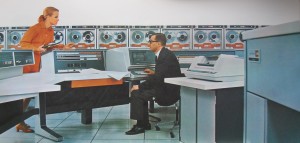
At some point we’ve all heard, “it will be the last one you buy.” Maybe it was a record player or a VCR. But at some point each needs to be replaced because technology changes. It’s rare to find a store selling either media.
When small equipment becomes outdated it’s easy to justify purchasing new. However, when large capital equipment goes out-of-date justifying replacement is difficult. Instead of a few hundred dollars, companies have to invest tens of thousands.
Last week I had the pleasure of visiting a company with that dilemma. A key piece of equipment in their company required an outdated operating system. As well, each computer connecting to it needed to be of similar vintage.
Each person within the company sits behind a similar old piece of equipment which needs to be functioning in order for the business to operate. Each computer has a different and necessary function. Upgrading to newer computers is not an option.
Years ago I used to sell capital equipment to the semiconductor industry. One of the most common questions I was asked revolved around upgradability. My stock answer was “yes, this is upgradable.” I had no way of predicting future changes to the industry or supporting technology.
Unfortunately we can’t predict the future when purchasing equipment either. This business couldn’t have predicted that Apple would have changed technical platforms from Motorola to Intel based systems. Had Apple continued using Motorola my customer’s piece of equipment wouldn’t need total updating.
This is not the first time I’ve seen this in business. A transportation customer of mine schedules their routes using a Windows 98 based computer and software from that era. Their initial software purchase was somewhere in the $10,000.00 range. Their vendor changed the software completely including database structure and operating system compatibility.
Updating to the newest software revision requires an investment of $20,000.00 plus new computers. In addition to shelling out cash they would have substantial downtime while data from each database is manually transposed to the new system. The transportation company’s software manufacturer didn’t create a means to simply import the old.
Outsiders may look at a business and see beige computers and old technology and immediately think they aren’t up to date. On the contrary, those businesses may not need the most modern technology to survive and run smoothly. Businesses exist for one reason: to make money. As long as they’re generating a profit, technology doesn’t matter.
One of the largest issues facing companies like these is the availability of older technology to support a decade old infrastructure. It’s getting much more difficult to put my hands on Windows 98 computers and G4 Macs. To keep some of these businesses alive requires sourcing products from scrap yards and online vendors like eBay.
Because most of the old equipment has been recycled or scrapped, procuring it takes some time. This has made supporting some of the older equipment much more difficult. My first business example uses Apples. I called six scrap yards searching for the exact replacement before I finally located the system I needed in Michigan. My customer will have to make due until the new system arrives.
As I stated earlier, the function of any business is to generate money. Obsolete technology supporting the business doesn’t mean failure though it can sometimes create a hurdle. A wise business person should recognize when obsolete technology hinders their business’s function.
(Jeromy Patriquin is the President of Laptop & Computer Repair, Inc. located at 509 Main St. in Gardner. You can text him directly at (978) 413-2840 or visit www.LocalComputerWiz.com.)
